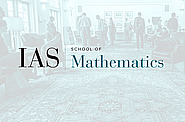2004-2005 seminars
Apr
19
2005
Computer Science/Discrete Mathematics Seminar II
Additive Approximation for Edge-Deletion Problems
10:30am|S-101
Apr
18
2005
Computer Science/Discrete Mathematics Seminar I
Towards Strong Inapproximability Results in the Lovasz-Schrijver Hierarchy
Iannis Tourlakis
11:15am|S-101
Apr
13
2005
Special Computer Science/Discrete Mathematics Seminar III
Linear-Degree Extractors and the NP-Completeness of Approximating Clique and Chromatic Number
11:15am|S-101
Apr
12
2005
Computer Science/Discrete Mathematics Seminar II
Cuts, Quadratic Programs and in Between
Muli Safra
10:30am|S-101
Apr
11
2005
Computer Science/Discrete Mathematics Seminar I
Aggregating Inconsistent Information: Ranking and Custering
11:15am|S-101
Apr
05
2005
Apr
04
2005
Computer Science/Discrete Mathematics Seminar I
Conflict-Free Colorings
Shakhar Smorodinsky
11:15am|S-101
Mar
29
2005
Computer Science/Discrete Mathematics Seminar II
Controlled Linear Programming and Linear Complementarity for Some Infinite Games in NP $\cap$ coNP
Sergei Vorobyov
10:30am|S-101
Mar
28
2005
Computer Science/Discrete Mathematics Seminar I
Max Cut - A Combinatorial Perspective
Benny Sudakov
11:15am|S-101
Mar
22
2005
Computer Science/Discrete Mathematics Seminar III
Information Theory and Probability Estimation
Alon Orlitsky
11:30am|S-101
